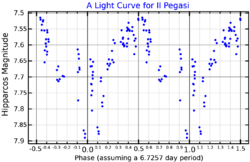Astronomy:II Pegasi
| Observation data Equinox J2000.0]] (ICRS) | |
|---|---|
| Constellation | Pegasus |
| Right ascension | 23h 55m 04.05313s[2] |
| Declination | +28° 38′ 01.2422″[2] |
| Apparent magnitude (V) | 7.4[3] (7.18–7.78[4]) |
| Characteristics | |
| II Pegasi A | |
| Evolutionary stage | subgiant[5] |
| Spectral type | K2 IV[5] |
| Variable type | RS CVn[4] |
| II Pegasi B | |
| Evolutionary stage | main sequence[5] |
| Spectral type | M0-M3 V[5] |
| Astrometry | |
| II Pegasi A | |
| Radial velocity (Rv) | −20.50[6] km/s |
| Proper motion (μ) | RA: 576.22[2] mas/yr Dec.: 34.69[2] mas/yr |
| Parallax (π) | 25.06 ± 0.51[2] mas |
| Distance | 130 ± 3 ly (39.9 ± 0.8 pc) |
| Absolute magnitude (MV) | 3.8[5] |
| Details | |
| II Pegasi A | |
| Mass | 0.8[5] M☉ |
| Radius | 3.4[5] R☉ |
| Luminosity | 1.06 L☉ |
| Surface gravity (log g) | 3.2[5] cgs |
| Temperature | 4,600[5] K |
| II Pegasi B | |
| Mass | 0.4[5] M☉ |
| Luminosity | 0.53 L☉ |
| Other designations | |
| Database references | |
| SIMBAD | data |
II Pegasi is a binary star system in the constellation of Pegasus with an apparent magnitude of 7.4 and a distance of 130 light-years. It is a very active RS Canum Venaticorum variable (RS CVn), a close binary system with active starspots.
The primary (II Pegasi A) is a cool subgiant, an orange K-type star. It has begun to evolve off the main sequence and expand.[5] Starspots cover about 40% of its surface. The star produces intense flares observable at all wavelengths.[7]
Its smaller companion (II Pegasi B) is too close to have been observed directly. It is a red dwarf, an M-type main-sequence star. The stars are tidally locked in a very close orbit with a period of 6.7 days and a separation of a few stellar radii.[5]
X-ray flares from II Pegasi A were observed with the Ariel 5 satellite in the 1970s and with later X-ray observatories. In December 2005, a superflare was detected by the Swift Gamma-Ray Burst Mission.[3] It was the largest stellar flare ever seen and was a hundred million times more energetic than the Sun's typical solar flare.[8]
References
- ↑ "Hipparcos Tools Interactive Data Access". ESA. https://www.cosmos.esa.int/web/hipparcos/interactive-data-access.
- ↑ 2.0 2.1 2.2 2.3 2.4 Van Leeuwen, F. (2007). "Validation of the new Hipparcos reduction". Astronomy and Astrophysics 474 (2): 653–664. doi:10.1051/0004-6361:20078357. Bibcode: 2007A&A...474..653V.
- ↑ 3.0 3.1 Osten, Rachel A.; Drake, Stephen; Tueller, Jack; Cummings, Jay; Perri, Matteo; Moretti, Alberto; Covino, Stefano (2007). "Nonthermal Hard X-Ray Emission and Iron Ka Emission from a Superflare on II Pegasi". The Astrophysical Journal 654 (2): 1052–1067. doi:10.1086/509252. Bibcode: 2007ApJ...654.1052O.
- ↑ 4.0 4.1 Samus, N. N. et al. (2009). "VizieR Online Data Catalog: General Catalogue of Variable Stars (Samus+ 2007-2013)". VizieR On-line Data Catalog: B/GCVS. Originally Published in: 2009yCat....102025S 1. Bibcode: 2009yCat....102025S.
- ↑ 5.00 5.01 5.02 5.03 5.04 5.05 5.06 5.07 5.08 5.09 5.10 5.11 Berdyugina, Svetlana V.; Jankov, S.; Ilyin, I.; Tuominen, I.; Fekel, F. C. (1998). "The active RS Canum Venaticorum binary II Pegasi. I. Stellar and orbital parameters". Astronomy and Astrophysics 334: 863–872. Bibcode: 1998A&A...334..863B.
- ↑ Karataș, Yüksel; Bilir, Selçuk; Eker, Zeki; Demircan, Osman; Liebert, James; Hawley, Suzanne L.; Fraser, Oliver J.; Covey, Kevin R. et al. (2004). "Kinematics of chromospherically active binaries and evidence of an orbital period decrease in binary evolution". Monthly Notices of the Royal Astronomical Society 349 (3): 1069–1092. doi:10.1111/j.1365-2966.2004.07588.x. Bibcode: 2004MNRAS.349.1069K.
- ↑ Covino, S.; Tagliaferri, G.; Pallavicini, R.; Mewe, R.; Poretti, E. (2000). "The active binary star II Pegasi with it BeppoSAX". Astronomy and Astrophysics 355 (2): 681–687. Bibcode: 2000A&A...355..681C.
- ↑ Wanjek, Christopher (6 November 2006). "Monster Stellar Flare Seen by NASA Scientists Dwarfs All Others". National Aeronautics and Space Administration. http://www.nasa.gov/mission_pages/swift/bursts/monster_flare.html.
 |


